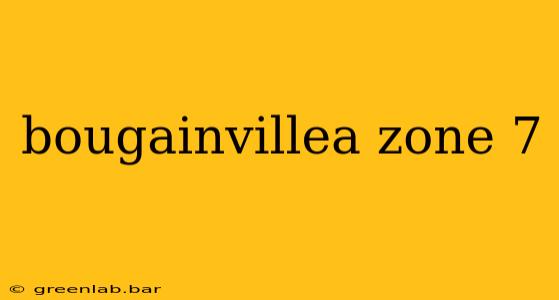Bougainvillea, with its vibrant bracts of color, is a captivating plant often associated with warm, tropical climates. While it thrives in warmer zones, growing bougainvillea successfully in Zone 7 requires a strategic approach. This comprehensive guide will explore the challenges and rewards of cultivating this stunning plant in a potentially less-than-ideal climate, providing you with the knowledge to ensure its flourishing.
Understanding Zone 7's Climate Challenges for Bougainvillea
Zone 7 experiences a wider temperature range compared to bougainvillea's native habitat. The primary challenges include:
- Winter Cold: Freezing temperatures can severely damage or even kill bougainvillea. Zone 7 winters, while not always brutally cold, can pose a significant threat.
- Shorter Growing Season: The shorter growing season limits the time bougainvillea has to establish itself and produce its spectacular blooms.
- Potential for Frost: Unexpected frost events can be devastating, impacting the plant's health and flowering.
Strategies for Successful Bougainvillea Cultivation in Zone 7
Despite these challenges, with proper care and attention, you can successfully grow bougainvillea in Zone 7. Here's how:
1. Choosing the Right Variety
Selecting a variety known for its cold hardiness is crucial. Some bougainvillea cultivars demonstrate greater tolerance to cooler temperatures than others. Researching varieties specifically bred for colder climates will significantly improve your chances of success. Look for descriptions that highlight cold tolerance or suitability for Zone 7 or similar zones.
2. Container Gardening: The Key to Zone 7 Success
Growing bougainvillea in containers offers several advantages in Zone 7:
- Mobility: You can move containers indoors or to a protected location during cold snaps, shielding the plant from damaging temperatures.
- Soil Control: You can use a well-draining potting mix specifically formulated for bougainvillea, ensuring optimal root health.
- Root Protection: Containers provide insulation, protecting the roots from the cold ground in winter.
3. Providing Optimal Sunlight and Warmth
Bougainvillea requires abundant sunshine—at least six hours a day. Choose a sunny location, ideally against a south-facing wall that can provide additional warmth.
Consider using a greenhouse or grow lights during the colder months to supplement sunlight and provide extra warmth.
4. Watering and Soil Requirements
Bougainvillea prefers well-draining soil. Avoid overwatering, which can lead to root rot, especially during colder months when the plant's growth slows. Allow the soil to dry slightly between waterings. Use a balanced fertilizer during the growing season to promote healthy growth and abundant blooms.
5. Winter Protection: The Crucial Step
Winter protection is paramount for bougainvillea in Zone 7. Here are several strategies:
- Indoor Overwintering: Move container-grown bougainvillea indoors to a bright, cool location (around 50-55°F) during winter. Reduce watering frequency.
- Protective Covering: If leaving the plant outdoors, wrap it with burlap or frost cloth to protect it from freezing temperatures.
- Mulching: Mulching around the base of the plant can help insulate the roots.
6. Pruning and Shaping
Regular pruning helps maintain the shape and encourages denser growth and more flowers. Prune lightly after flowering in the fall or early winter.
Reaping the Rewards: The Beauty of Zone 7 Bougainvillea
While it requires more care than in warmer climates, growing bougainvillea in Zone 7 offers a rewarding experience. The vibrant color and lush foliage provide a stunning focal point in your garden, bringing a touch of the tropics to your landscape. By diligently following these guidelines, you can enjoy the beauty of this magnificent plant even in a cooler climate. Remember that patience and attention to detail are key to success!

